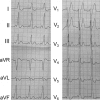Catheter radiofrequency ablation for arrhythmias under the guidance of the Carto 3 three-dimensional mapping system in an operating room without digital subtraction angiography
- PMID: 29923993
- PMCID: PMC6023703
- DOI: 10.1097/MD.0000000000011044
Catheter radiofrequency ablation for arrhythmias under the guidance of the Carto 3 three-dimensional mapping system in an operating room without digital subtraction angiography
Abstract
Several studies have reported the efficacy of a zero-fluoroscopy approach for catheter radiofrequency ablation of arrhythmias in a digital subtraction angiography (DSA) room. However, no reports are available on the ablation of arrhythmias in the absence of DSA in the operating room. To investigate the efficacy and safety of catheter radiofrequency ablation for arrhythmias under the guidance of a Carto 3 three-dimensional (3D) mapping system in an operating room without DSA. Patients were enrolled according to the type of arrhythmia. The Carto 3 mapping system was used to reconstruct heart models and guide the electrophysiologic examination, mapping, and ablation. The total procedure, reconstruction, electrophysiologic examination, and mapping times were recorded. Furthermore, immediate success rates and complications were also recorded. A total of 20 patients were enrolled, including 12 males. The average age was 51.3 ± 17.2 (19-76) years. Nine cases of atrioventricular nodal re-entrant tachycardia, 7 cases of frequent ventricular premature contractions, 3 cases of Wolff-Parkinson-White syndrome, and 1 case of typical atrial flutter were included. All arrhythmias were successfully ablated. The procedure time was 127.0 ± 21.0 (99-177) minutes, the reconstruction time was 6.5 ± 2.9 (3-14) minutes, the electrophysiologic study time was 10.4 ± 3.4 (6-20) minutes, and the mapping time was 11.7 ± 8.3 (3-36) minutes. No complications occurred. Radiofrequency ablation of arrhythmias without DSA is effective and feasible under the guidance of the Carto 3 mapping system. However, the electrophysiology physician must have sufficient experience, and related emergency measures must be present to ensure safety.
Conflict of interest statement
The authors have no funding and conflicts of interest to disclose.
Figures






References
-
- Zhu TY, Liu SR, Chen YY, et al. Zero-fluoroscopy catheter ablation for idiopathic premature ventricular contractions from the aortic sinus cusp [in Chinese]. Nan Fang Yi Ke Da Xue Xue Bao 2016;36:1105–9. - PubMed
-
- Giaccardi M, Del Rosso A, Guarnaccia V, et al. Near-zero x-ray in arrhythmia ablation using a 3-dimensional electroanatomic mapping system: a multicenter experience. Heart Rhythm 2016;13:150–6. - PubMed
-
- Kerst G, Parade U, Weig HJ, et al. A novel technique for zero-fluoroscopy catheter ablation used to manage Wolff-Parkinson-White syndrome with a left-sided accessory pathway. Pediatr Cardiol 2012;33:820–3. - PubMed
Publication types
MeSH terms
LinkOut - more resources
Full Text Sources
Other Literature Sources
Medical

